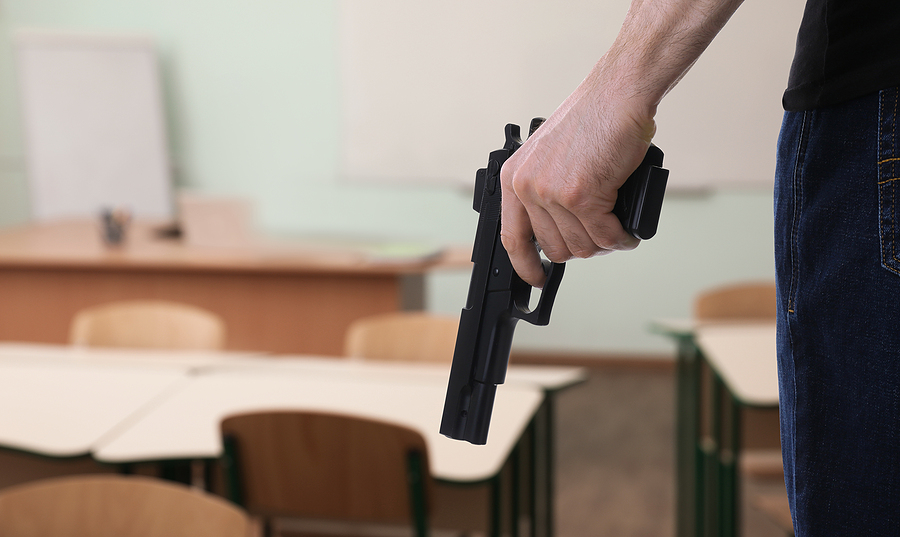
Duty and Standard of Care for Prevention of School Shootings
Schools have a duty to protect students, faculty, and staff from harm arising from acts of violence, such as school shootings, when the harm is reasonably foreseeable. However, schools are not built like fortresses, nor should they be. It is not the latest security technology, metal detectors, or an indoor active-shooter detection system that are critical for providing the safest environment possible in a school setting. Rather, it is the culture and climate that exist in the school; the policies, procedures, and protocols in place for maintaining a safe environment; and, most importantly, the implementation of those policies, which includes adequate training, supervision, and support. While there are no guarantees, this article offers information that can help with minimizing the risk of school shootings and associated harm to students and staff.
Moreover, teachers and administrators must be trained to respond to reports or red flags that school shootings could occur. The people in the building and their collaboration with outside agencies, such as public safety, form the real backbone of any security system in our schools. In my professional experience as a school and district administrator, a school without standard policies, procedures, and protocols and a school community that does not practice a culture of school safety will have a higher risk of violence than a school with those policies, practices, and culture in place.
School Shootings are Foreseeable and Are an Established Risk of Harm
School shootings are an established and foreseeable risk that schools have a duty to try to reduce at all times. According to the K-12 School Shooting Database, which has recorded all K-12 school shootings from 1970 to the present, 332 people were shot (fatal and wounded) in 303 separate incidents on K-12 school property in 2022, the highest single-year total in the database. In fact, the last five calendar years (2018–2022) have seen the highest 5-year total of K-12 shootings and incidents. Between the time of the shootings at Columbine High School on April 20, 1999, and at Ridgeview Jr. High School, in Pickering, Ohio, on February 2, 2023, more than 338,000 students have experienced and been exposed to school gun violence at 366 K-12 schools in the United States. Tragically, during this 24-year span, 191 children, educators, and other people have been killed, and another 414 have been injured.
School safety and security standards related to school shooting prevention are derived from federal and state laws, as well as research-based recommendations and best practices. A school’s duty to prevent and reduce the risk of school shootings lies in determining the approach best aligned with the school’s unique needs, culture, location, and population.
School Shooting Prevention Standards and Practices
Each state has enacted laws and regulations for keeping school students, faculty, and staff safe from acts of violence. For example, in Colorado, home to some of the deadliest school shootings in the United States, the Claire Davis School Safety Act “imposes a limited waiver of sovereign immunity for schools if a school fails to exercise ‘reasonable care’ to protect all students, faculty, and staff from ‘reasonably foreseeable’ acts of violence that occurs at school or a school-sponsored activity” (Colorado School Safety Resource Center, n.d., para. 1). The act, passed in 2015, was named after high school senior Claire Davis was killed in a shooting at Arapahoe High School in Centennial, Colorado, in 2013. Another example is in 2022, New Jersey passed P.L. 2022, c. 83, which requires all public schools to develop multidisciplinary threat-assessment teams. Furthermore, Massachusetts passed Section 363 of Chapter 159 of the Acts of 2000, which requires all school districts to formulate multi hazard evacuation plans that encompass, among other emergencies, school shootings and other terrorist activities and bomb threats.
In addition to state standards, there are federal guidelines and standards that recommend proactive steps, including adequate security precautions and training for school shooting prevention. For example, the STOP School Violence Act of 2018 gives the United States Department of Justice authority to provide grants to public agencies, including school districts, to improve security on school grounds through evidence-based safety programs. Other federal standards include, but are not limited to those issued by, the United States Secret Service National Threat Assessment Center, the United States Department of Education, the United States Department of Homeland Security, the United States Department of Health and Human Services, the United States Department of Justice, and other professional organizations that protect students, faculty, and staff from incidents of school violence. In 2013, these agencies developed a Guide for Developing High-Quality School Emergency Operations Plans, which provided a process for developing, implementing, and continually refining a school or district Emergency Operating Plan (EOP). Based on lessons learned from previous incidents, the guide describes five areas in which schools should focus on lowering the risk of school shootings:
- Prevention: actions schools take to prevent a threatened or actual incident from occurring
- Protection: actions that protect students, teachers, staff, visitors, networks, and property from a threat
- Mitigation: capabilities necessary for schools to reduce the likelihood that a threat will materialize and to eliminate or reduce loss of life by lessening the impact of an event
- Response: the capabilities necessary to stabilize a situation once an emergency has occurred or cannot be prevented; to establish a safe and secure environment; to save lives and property; and to facilitate transition to recovery
- Recovery: the capabilities necessary to assist schools affected by an event or emergency in restoring the learning environment (U.S. Department of Education [USDOE], 2013, p. 2)
All five areas are important. From a school-liability perspective, however, the areas of prevention, protection, and mitigation are critical for reducing the risk that a shooting will occur, and ultimately, save lives and injuries from occurring. Liability for school shootings depends on the reasonable implementation of standards related to these areas.
Safety and Security Standards for School Shooting Prevention
Based on best practices and appropriate standards of care promulgated by federal, state, and independent agencies, schools and districts should focus on the following areas when working to reduce the risk of school shootings and to provide a safe and secure environment:
- Establish multidisciplinary school and district safety-planning teams. These teams should contain school and community officials and staff, including administrators, teachers, nurses, school psychologists, school resource officers, and other important personnel. In addition, these teams should be trained in at least the Incident Command System Basic Training (ICS-100) and National Incident Management System (NIMS ICS-700).
- Write and update annual school-safety plans. It is important to update safety plans on a periodic basis to reflect changes in policies, procedures, facilities, staff, and students. The multidisciplinary safety planning team should take responsibility for making updates. The Northeastern Massachusetts Law Enforcement Council (NEMLEC) offers one example of a school emergency operations plan.
- Conduct drills for active-shooter situations. To be prepared for an active-shooter incident, schools should train staff, students (in a developmentally appropriate manner), and families, as appropriate, in what to expect and how to react. Drills must include first responders, school resource officers, and public safety to ensure that everyone knows their roles. In addition, there should be appropriate plans in place for evacuation and reunification after a school shooting occurs. Drills should teach students and staff how to evacuate or lock down students, staff, and visitors, including those who are not with staff or in a classroom (e.g., in the hall, bathroom, or break room). Special attention should be paid to students with disabilities who may have accessibility issues when going to shelter or evacuation. NEMLEC provides a template for an emergency training chart.
- Conduct annual community and building-security assessments and address safety concerns immediately. Schools and districts should work with their facilities departments and school safety teams to ensure that schools are physically secure and safe from intruders. NEMLEC also provides an example of a school-safety audit review checklist. This audit should include checking all exterior and interior windows, doors, and locks; making sure surveillance cameras are functioning; eliminating unnecessary vegetation around the school; developing protective barriers, such as bollards, on the exterior entrances of the school; and other important physical enhancements.
- Develop and effectively implement policies and procedures regarding school safety and security. Policies and procedures should govern the hiring and background checks of employees and volunteers, visitor and vendor procedures, a single point of entry for student arrival and departure, locked exterior doors, key access for staff, before- and after-school security, hall-pass policies, open campus for older students, field trips, surveillance-camera use, and other important issues. A sample Massachusetts School Committee Policy can be found online.
- Develop and implement protocols and training for staff on how to recognize students at risk and warning signs that they may be at risk. No profile exists for an active shooter; however, research indicates there may be signs or indicators. Schools should learn the signs of a student who is at risk of harming themselves or others and proactively seek ways to prevent an incident through the use of either internal resources or external assistance (USDOE, 2013, p. 59). Such warning signs may include declining grades, excessive absences or tardiness, disciplinary issues, unusual or unique behavior, suicidal ideation, bullying and harassment (either as the victim or the perpetrator), signs of substance use, interest or access to weapons, and changes in personality.
- Develop and train a multidisciplinary threat-assessment team with specific policies and procedures. A threat assessment identifies and seeks to manage student behaviors of concern. The threat-assessment process is one component of an overall strategy to reduce school violence and create safe and supportive school climates. During this process, the threat-assessment team gathers and analyzes information about the behaviors and communications of a student of concern. Based on this information, a determination is made as to whether that student may be moving along a path toward an attack on an identifiable target. The United States Secret Service has developed 11 key questions that should be used during a threat assessment inquiry for school shootings. NEMLEC offers one example of what may be included in a threat-assessment investigative resource.
- Focus on developing a culture that focuses on safety, respect, and emotional support. School environments should reflect a culture and climate where students, teachers, and administrators pay attention to students’ social and emotional needs, as well as their academic needs. According to the United States Department of Education and the United States Secret Service, “In an educational setting where there is a climate of safety, adults and students respect each other. This climate is defined and fostered by students having a positive connection to at least one adult in authority. In such a climate, students develop the capacity to talk and openly share their concerns without fear or shame and reprisal. They try to help friends and fellow students who are in distress, bringing serious concerns to the attention of adults” (U.S. Secret Service & USDOE, 2004, p. 6). It is important to gauge a school’s climate on a periodic basis by administering climate surveys for students, staff, and parents. This tool will give school and district safety committees important insights into whether adjustments are needed. In addition, schools should have a tool for students, staff, or families to report anonymous concerns or red flags. Schools that take these steps may have fewer situations that require formal threat assessments.
- Develop a working relationship with local law enforcement and public safety agencies. It is absolutely essential that a strong collaboration exists between schools and local police, fire, and emergency medical services. Written agreements or memoranda of understanding (MOU) between school districts and law enforcement agencies should follow state laws [or regulations] governing information sharing and the roles responsibilities of each party. If available and when used appropriately, school resource officers can be an essential component to a school response plan and be that vital link between schools and law enforcement.
- Finally, take all reports and red flags seriously. This may be the most important point of all. In many school shootings, warning signs were ignored and schools and districts failed to respond to information. A social media post that may have been ignored, exterior doors not getting locked in the morning, staff and students not being trained in active shooter drills, a student who is missing classes without any follow-up, or threat-assessment policies not being implemented properly are all examples of warning signs and failures not being addressed. A report on the Arapahoe High School (AHS) shooting in Littleton, Colorado, states, “The evidence indicates that several individual staff at AHS and within Littleton Public Schools (LPS) made many small errors. More significant is the fact that the system in place within the school and the district failed catastrophically — in both the prevention of school violence and the promotion of school safety” (Goodrum & Woodward, 2016, pp. 1-2). Administrators need to develop a culture, an expectation, and a practice that takes reports and red flags seriously. In many instances, if just one or two decisions were made differently or the information from reports were taken seriously, a school shooting may have been prevented.
Columbine High School, Virginia Tech University, Sandy Hook Elementary School, Parkland High School, Robb Elementary School, Richneck Elementary School, and most recently, Michigan State University are, unfortunately, more synonymous with a school shooting than the education that they provide for their students. These schools are just a few of the many sites of school and university shootings since 1999. Incidents of school violence, such as school shootings, have been prevalent and a known and foreseeable risk in schools for more than 20 years, since the massacre at Columbine High School in 1999. Even when deaths do not occur, school shootings can have physical and emotional impacts on families, students, teachers, administrators, and staff. Take, for example, the school shooting at Richneck Elementary School in Newport News, Virginia, on January 6, 2023, in which a 6-year-old student was alleged to have intentionally shot a teacher, Abigail Zwerner. Ms. Zwerner safely escorted students out of her classroom, even though she had been wounded. However, she will need several months to recover, and students and staff in that school will carry that emotional trauma with them for the rest of their lives.
Standards discussed in this article will not guarantee that a shooting will not occur in a school. However, by applying these standards and continually updating policies, procedures, training, and drills that are based on the latest research and best practices, the risk of school shootings and the associated school liability and damages may be reduced.
References
Colorado School Safety Resource Center. (n.d.). Claire Davis School Safety Act (C.R.S. 24-10-106.3). https://cssrc.colorado.gov/claire-davis-school-safety-act
Goodrum, S., & Woodward, W. (2016, January 18). Report on the Arapahoe High School shooting: Lessons learned on information sharing, threat assessment, and systems integrity. https://cdpsdocs.state.co.us/safeschools/Resources/AHS-reports/CSPV.AHSFullReport.pdf
U.S. Department of Education, Office of Elementary and Secondary Education, Office of Safe and Healthy Students. (2013, June). Guide for developing high-quality school emergency operations plans. https://rems.ed.gov/docs/School_Guide_508C.pdf
U.S. Secret Service & U.S. Department of Education. (2004, July). Threat assessment in schools: A guide to managing threatening situations and to creating safe school climates. https://rems.ed.gov/docs/ThreatAssessmentinSchools.pdf


